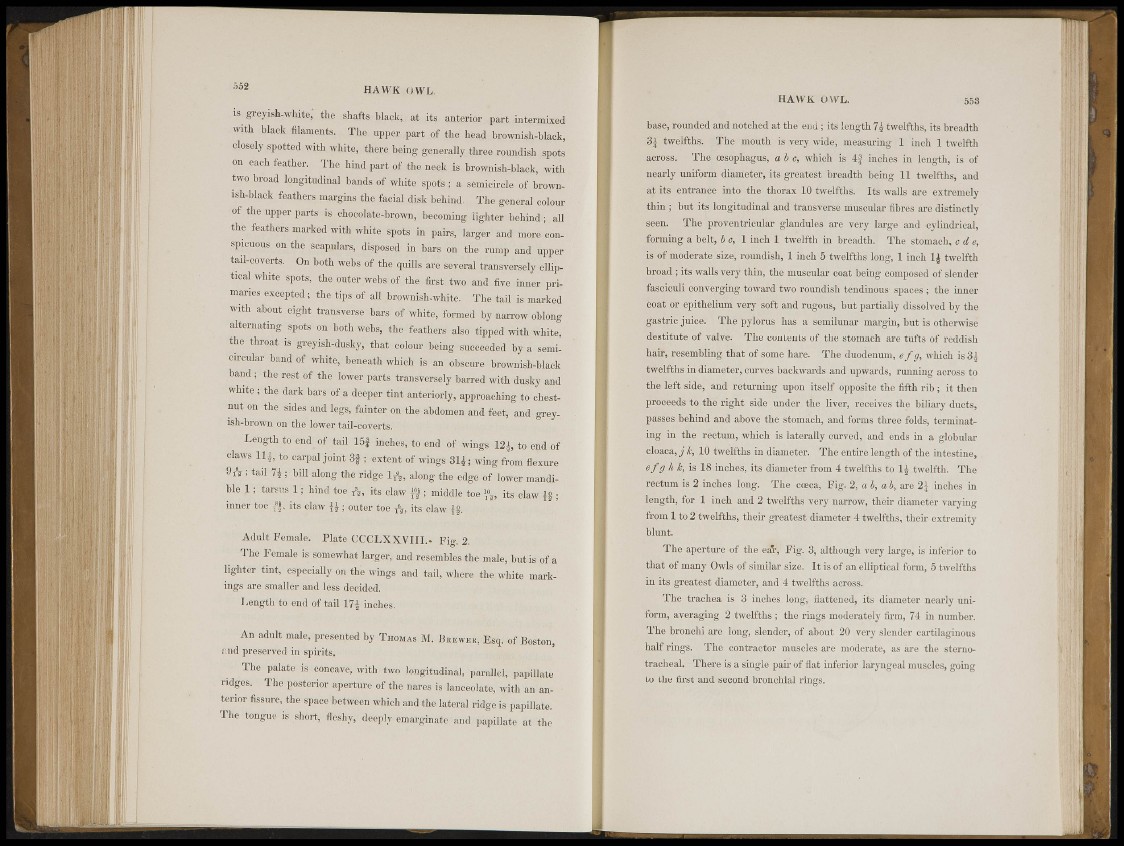
;i52 HAWK OWL.
-is greyish-white; $ 8 shaf t s black , at autori,»- part intermixed
with black filaments. The upper p a r t ^ f the head b r o ^ h - b l a c k ,
closely gpg|ted with white, there being generally three roundish spots
on eacji .feather. The, hind part qf. the neck is brownish-black, with
two broad longitudinal bands of white'fpots ; a sèmicirpìe S b r own -
ish-black feathers margins the facial digk behind^ The general colour
•of the upper parts is cbocol'ate-brown,, becoming lighter b e h i n d j l § g
the feathers marked with white spots in pairs, larger and more conspicuous
mi the scapulars, disposed in bars o ^ ' t p ' r ump ' a n d u p p e r
tad-coverts On both webs of the quills are several t ransvi sely dlTptical
white spots; the buter websiq^the first, two and S e innés primaries
excepted, the tips' # S > o w m s h - w h r t e The tail is marked
with a]6out eight t r a r t ^ s r - t e s ofrVhite, . fetned by narrow qbl&g
alternating ^ j o t ^ n b o t h ^ h s , t h e - f e a t i ^ ' a f c . tipped with whit«,
the thj»at is '"greyish-duskJ?~thait coloto being'succeeded by a semi*
* circular ban^ o f white, b e î ^ t h which is an obscure brownish-black
band ; the ¡rest ¡if'We lower parts traj-.svorsely barred with dusky and
white ; the dark bari, of a deeper tint anteriorly, approaching to chestnut
on the -sides and ljgfe; fainter on the abdomen and feet, and greyish
brown on the lower tail-ddfertfe' ' »
l eng th to end of tail 15f in'chW.^to end of wings 121, to end of
I B 8 B B C a r p a l j 0 Ì m t * * 5 e x t e n t : o f 31è ; wsînif ftom flexum
9 A , tail 7 i î ' b g a l o n g the ridge I-ft, along the edge of lower mandible
1 tarsus T ; hind toe A , its claw $ ; middle toe its claw ;
inner 1 a j i | | i : i t g cliw ¡ J ; outer tuiuft, its claw
A,lull lùamile. Plate C. 'CCI .XXVI J I . . f i g ; 2.
The Female is somewhat large« and iëlejnWës the male, but is of a
lighter tint, especially on the wings and tail, where ;the, white markings
an; smaller and less decided.
Length to end1 of tail 174 inche®-it'
An adult male, presented by Thomas Al. Hkkwkr, Ksij. of Boston,
¡.lid preserved ir. spirits.
T h ( " l'albo is concave, with two longitudinal, parallel, papillate
ridges. The posterior aperture of thé1 nares is lanìeòla«£ with an antenor
fissure, the spaee between which and the lateral ridge is papillate.
TlfeÉÉèngue is short, > 0 5 % deeply emarginate and papillate at the
HAWK OWL. 553
base, rounded and notched at the end; its length 7¿ twelfths, its breadth
3 | twelfths. The mouth is very wide, measuring 1 inch 1 twelfth
across. This oesophagus, a b c, which is 4f inches in length, is of
nearly uniform diameter, its greatest breadth being 11 twelfths, and
a | its entrance into the thorax 10 twelfths. Its walls are extremely
thin; but its longitudinal and transverse muscular fibres are distinctly
seen. The proventricular glandules are Wry large and cylindrical,
forming a belt, le, 1 inch |: twelfth in breadth. The stomach, c d e,
is of moderate size, roundish,, 1 inch 5 twelfths long, 1 inch twelfth
broad; its walls very thin, the muscular coat being composed of slender
fasciculi converging tmvard two roundish tendinous spaces; the inner
3p>ai or epithelium very soft and rugous, but partially dissolved by the
gastric juice. The pylorus has a semilunar margin, but is otherwise
destitute of valve. The contents of the stomach are tufts of reddish
hair, resembling that of some hare. The duodenum, e f g , which is
twelfths in diameter, curves backwards and upwards, running across to
the left sido, and Returning upon itself opposite the fifth rib ; it then
proceeds to the right side under the liver, receives the biliary ducts,
passes behind and aboye the stomach, and forms three folds, terminating
in the rectum, which; is laterally curved, and ends in a globular
c l o a c a , 1 0 twelfths in diameter. The entire length of the intestine,
e f g h k, is 1« inches, its diameter from 4 twelfths to twelfth. The
rectum is 2 inches long. The cceea, Fig. 2, a 6, a i, are inches in
length, for 1 inch and 2 twelfths very narrow, their diameter varying
from 1 to 2 twelfths, their greatest diameter 4 twelfths, their extremity
blunt.
The aperture of the ear, Fig. 3, although very large, is inferior to
that of many Owls of similar size. It is. of an elliptical form, 5 twelfths
in its greatest diameter, and 4 twelfths across.
The trachea is 3 inches, long, flattened, its diameter nearly uniform,
averaging 2 twelfths; the rings moderately firm, 74 in number.
The bronchi are long, slender, of about 20 very slender cartilaginous
half rings. The contractor muscles are moderate, as are the sternotracheal.
There is a single pair óf flat inferior laryngeal muscles, going
to the first and second bronchial rings.